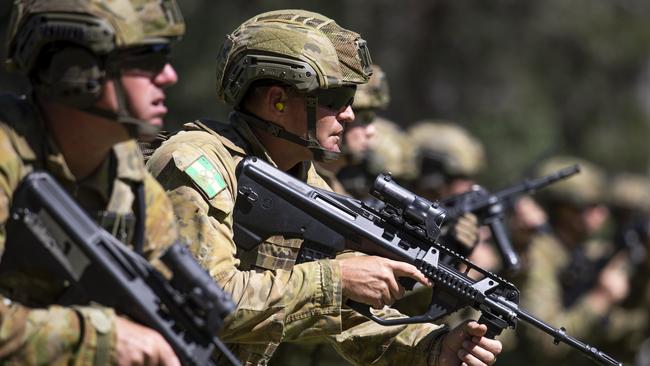Soldiering on: army fights for readiness amid coronavirus
War-fighting capability has always been the army’s No 1 priority, but training has been challenged by the coronavirus.

War-fighting capability has always been the Australian Army’s No 1 priority.
For the most part, having groups of soldiers train side-by-side, close to one another, is how that capability is maintained.
But as the highly contagious novel coronavirus wreaks havoc across the globe, leaving almost no one and no organisation unaffected, the army has faced a monumental challenge: how to protect its people, its warfighting capability and its ability to assist the community it serves.
“We made the decision to postpone all non-essential exercises and training,” Deputy Chief of Army Anthony Rawlins said. “This ensures our soldiers prioritise their health, and that of their families, while remaining ready to respond when called upon to support Australian communities.”
The cancellations include the most significant activity on the army’s training calendar — Exercise Hamel, originally scheduled for August with 8000 personnel set to take part.
Units have been directed not to exceed 50 per cent manning at any given time and soldiers are told to stay at home where possible.
At the time of writing, three members of the Australian Army had tested positive for COVID-19.
It’s a bleak picture in stark contrast to the usual hum of activity across bases where the daily rhythm revolves around physical training, section and platoon-level drills and camaraderie-building activities that take place on the sporting fields and inside the messes.
Yet morale is high — soldiers know the hardships people in the wider community are going through and are glad they can help if called upon. They are also acutely aware that their profession comes with unparalleled job security, meaning they can support their families during uncertain times.
The Australian Defence Force has adjusted its operational footing in response to the virus by relocating and redeploying non-essential personnel from Iraq and Afghanistan.
“This is a temporary measure to preserve the safety of our people and our partner forces,” a Defence spokesperson said. “The increasing risk of COVID-19 has forced the suspension of our training missions with our Afghan and Iraqi security partners.”
However, some advising still might take place via phone or video, the spokesperson said.
Some personnel have returned to Australia and remain ready to redeploy when circumstances improve. Those who were close to concluding their operational duties have been brought home, where they will stay.
The pandemic has taken hold during a period of relatively low operational tempo compared with the past two decades, when such an event might have been significantly more difficult for the army to manage.
It has continued to plan certification and readiness requirements to ensure it can meet the needs of Australia in the immediate, medium and long term.
The measures involve a delicate balancing act of maintaining readiness while adhering to public health guidelines to minimise the transmission of COVID-19.
As high-readiness units remain poised for the army’s more traditional range of operational contingencies, the others are on notice for Operation COVID-19 Assist, in which some units are already involved in supporting domestic measures to control the pandemic.
“Those deploying will be optimally trained and best prepared for the mission they are called upon to achieve,” Major General Rawlins said. “COVID-19 is forcing us to consider new ways to conduct this training and operational preparation.”
The army continues to train recruits at Kapooka and officer trainees at the Royal Military College — Duntroon. Recruits arriving at Kapooka are fed, housed and trained in isolation from the wider base population for their first 14 days of training.
The unprecedented nature of this crisis has created a positive catalyst for innovation.
“As with many other organisations and armies around the world, COVID-19 is providing us with the opportunity to be innovative, ” Major General Rawlins said.
Much of the innovation has involved using technology to train remotely. Online learning platforms have been enhanced, with a huge suite of technical training and professional military education made available.
One online course, compulsory for all, provides training to prepare soldiers for hospital duties they could be called on to conduct if the situation escalates. It focuses on the tasks of a hospital orderly: moving beds, cleaning and providing other general assistance.
Though soldiers now conduct physical training alone, fitness is being maintained through the online dissemination of highly personalised training programs, which include considerations for nutrition and injury rehabilitation.
In technology-slanted roles, some leaders have turned to online communication and collaboration systems and report improved productivity because of the highly efficient software.
Though there are few silver linings during the pandemic, being able to spend time with family at home is something that many who serve are treasuring.
And as Anzac Day approaches, army units and brigades have been working with veteran organisations to check in with those who previously have served under the Rising Sun or had a loved one who did.


